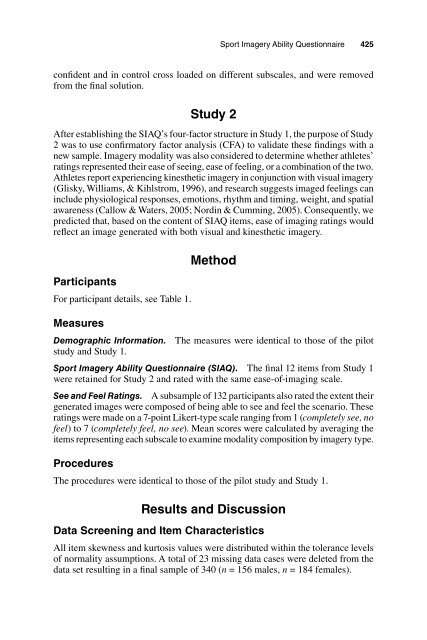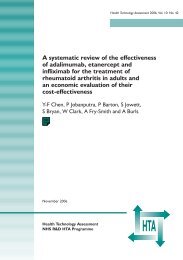Measuring Athlete Imagery Ability: The Sport ... - ResearchGate
Measuring Athlete Imagery Ability: The Sport ... - ResearchGate
Measuring Athlete Imagery Ability: The Sport ... - ResearchGate
Create successful ePaper yourself
Turn your PDF publications into a flip-book with our unique Google optimized e-Paper software.
<strong>Sport</strong> <strong>Imagery</strong> <strong>Ability</strong> Questionnaire 425<br />
confident and in control cross loaded on different subscales, and were removed<br />
from the final solution.<br />
Study 2<br />
After establishing the SIAQ’s four-factor structure in Study 1, the purpose of Study<br />
2 was to use confirmatory factor analysis (CFA) to validate these findings with a<br />
new sample. <strong>Imagery</strong> modality was also considered to determine whether athletes’<br />
ratings represented their ease of seeing, ease of feeling, or a combination of the two.<br />
<strong>Athlete</strong>s report experiencing kinesthetic imagery in conjunction with visual imagery<br />
(Glisky, Williams, & Kihlstrom, 1996), and research suggests imaged feelings can<br />
include physiological responses, emotions, rhythm and timing, weight, and spatial<br />
awareness (Callow & Waters, 2005; Nordin & Cumming, 2005). Consequently, we<br />
predicted that, based on the content of SIAQ items, ease of imaging ratings would<br />
reflect an image generated with both visual and kinesthetic imagery.<br />
Participants<br />
For participant details, see Table 1.<br />
Measures<br />
Method<br />
Demographic Information. <strong>The</strong> measures were identical to those of the pilot<br />
study and Study 1.<br />
<strong>Sport</strong> <strong>Imagery</strong> <strong>Ability</strong> Questionnaire (SIAQ). <strong>The</strong> final 12 items from Study 1<br />
were retained for Study 2 and rated with the same ease-of-imaging scale.<br />
See and Feel Ratings. A subsample of 132 participants also rated the extent their<br />
generated images were composed of being able to see and feel the scenario. <strong>The</strong>se<br />
ratings were made on a 7-point Likert-type scale ranging from 1 (completely see, no<br />
feel) to 7 (completely feel, no see). Mean scores were calculated by averaging the<br />
items representing each subscale to examine modality composition by imagery type.<br />
Procedures<br />
<strong>The</strong> procedures were identical to those of the pilot study and Study 1.<br />
Results and Discussion<br />
Data Screening and Item Characteristics<br />
All item skewness and kurtosis values were distributed within the tolerance levels<br />
of normality assumptions. A total of 23 missing data cases were deleted from the<br />
data set resulting in a final sample of 340 (n = 156 males, n = 184 females).
















